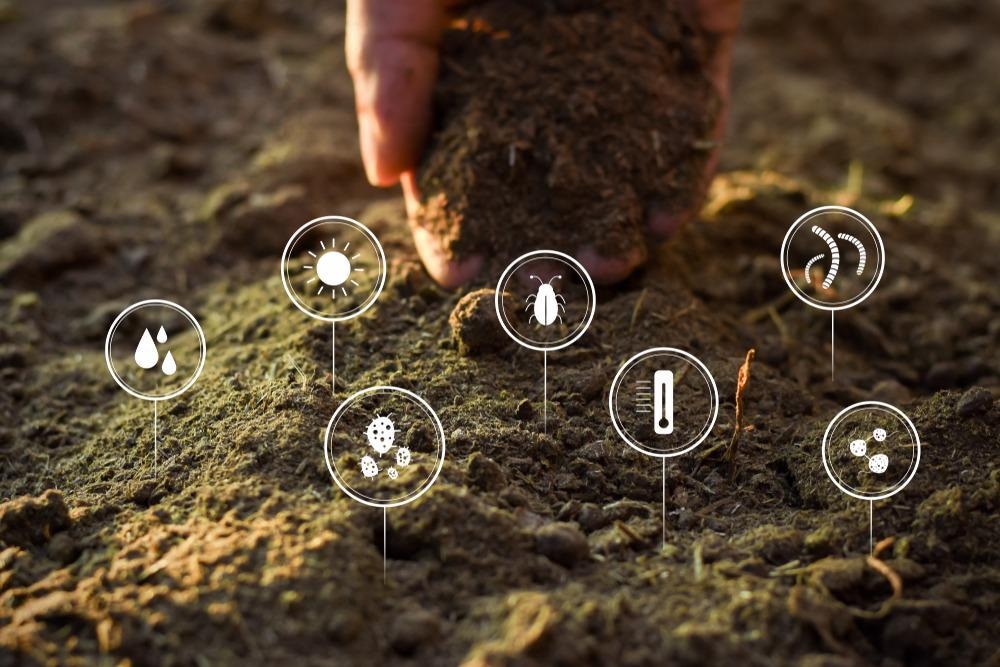
Introduction
Soil microbes and nutrient cycles
Types of soil and their microbial communities
References
Bacteria and other microorganisms are abundant throughout soils and deep into the ground and serve an essential role in the global ecosystem through various biochemical processes, particularly nitrogen fixation.
Bacteria and archaea are the most abundant microorganisms in soil, alongside many species of fungi, algae, and protozoa. Actinobacteria are a type of bacteria mainly found in soils and water with great physical similarities to fungi due to convergent evolution, both fulfilling the role of organic matter decomposers. For this reason, they were misidentified for many years. Archaea fill similar roles to bacteria in soils and have been demonstrated to form distinct soil or water-based communities in the same manner.
Fungi are far less prevalent in soils when compared to the overwhelming quantity of bacteria but are thought to play a vital role in the initial breakdown of organic matter. Given this, fungi are more commonly found on larger coarse sand particles. Protozoa also play an essential role in the ecosystem and nutrient cycling, making nutrients available for other life forms. Protozoa consume bacteria and thus play a role in population control and the passing of nitrogen and other mineralized elements up the food chain.

Image Credit: kram-9/Shutterstock.com
Soil microbes and nutrient cycles
Soil-based microorganisms, especially bacteria, are responsible for most global nitrogen fixation, thereby making nitrogen available to the vast majority of life on Earth, which would otherwise be inaccessibly trapped in the air as molecular dinitrogen. These microorganisms generate ammonia from nitrogen, which can then be used by plants and eventually converted back to nitrogen gas. Various microorganisms employ at least 14 unique redox reactions to achieve the conversion of nitrogen compounds using enzymes.
Soil microorganisms are just as significantly involved in the biogeochemical cycling of numerous elements, including those most essential to life; carbon, oxygen, phosphorus, and sulfur, found in DNA and functional proteins. Without the metabolic activity of microorganism chemosynthesizers and photosynthesizers, these elements would remain trapped in the atmosphere, lithosphere, or oceans and be inaccessible to a higher life.
Indeed, the great oxidation event of approximately 2.2 billion years ago was caused by the proliferation of photosynthesizing cyanobacteria in the pedosphere (soils) and hydrosphere. During this time, the elemental composition of the atmosphere shifted significantly in oxygen levels, causing the earliest known mass extinction event of those organisms not able to adapt.

Image Credit: Lukasz Barzowski/Shutterstock.com
Types of soil and their microbial communities
Soil may be composed of a varied ratio of mineral and organic components of differing coarseness, from large granular sand to fine silt and clay, which may have respective mean soil particle diameters from 2 mm down to 0.002 mm, and is classified based on their percentage composition of sand, silt, and clay. Agriculture and other environmental conditions influence particle size and subsequently alter microbial activity.
Microbial biomass is most concentrated in soils containing smaller particles owing to the greater surface area available, though some strains of bacteria thrive better in either clay or sandy soils. For example, α-Proteobacteria has been demonstrated to preferentially culture on larger particles, Acidobacterium on smaller. Despite this exhibited preference for soil particle size, the diverse nature of soils ensures that any given soil sample contains a considerable diversity of bacterial species.
Other important conditions regarding microbial activity within soil include moisture levels, pH, ambient temperature, frequency of cycling, and presence of organic nutrients, among an almost endless list. Peat is a type of soil containing a high percentage of organic matter due to the incomplete decomposition of plant matter in waterlogged conditions. Despite covering less than 4% of the Earth’s surface, peat contains as much as a third of the global carbon currently stored in soil.
Due to this huge carbon concentration, peat microbes have adapted to utilize the nutrient source, generating carbon dioxide and methane as metabolic products. More acidic and nutrient-poor peat supports less diverse microbial communities, and studies show that the metabolic profile of these communities can shift significantly and with great sensitivity in response to environmental changes. Peat bogs and fens are therefore of great environmental importance regarding climate change, where a change in temperature, moisture, or pH levels could hasten the generation of methane, further contributing to the climate change issue.
References:
- Tate. R. L. (2021) Soil Microbiology.
https://books.google.co.uk/books?hl=en&lr=&id=E48BEAAAQBAJ&oi=fnd&pg=PP15&dq=Microbiology+in+Soil+Science&ots=a5uffCqXke&sig=7Q8joV2qdqn6H-ir-d911eL-Uo4&redir_esc=y#v=onepage&q=Microbiology%20in%20Soil%20Science&f=false - Kuypers et al. (2018) The microbial nitrogen-cycling network. Nature reviews microbiology.
https://www.nature.com/articles/nrmicro.2018.9 - Chen et al. (2020) The Great Oxidation Event expanded the genetic repertoire of arsenic metabolism and cycling. PNAS.
https://www.pnas.org/content/117/19/10414 - Steward, J., et al. (2020) Peatland Microbial Community Composition Is Driven by a Natural Climate Gradient. Environmental microbiology, 80.
https://link.springer.com/article/10.1007/s00248-020-01510-z#:~:text=Results%20and%20Discussion-,Bacterial%20and%20Archaeal%20Community%20Composition,and%20Actinobacteria%20(6.9%25%3B%20Fig. - Jung, J., et al. (2020) Archaea, tiny helpers of land plants. Computational and Structural Biotechnology Journal, 18.
https://www.sciencedirect.com/science/article/pii/S2001037020303895 - Sessitsch, A., et al. (2001) Microbial Population Structures in Soil Particle Size Fractions of a Long-Term Fertilizer Field Experiment. Applied environmental microbiology, 67(9).
https://www.ncbi.nlm.nih.gov/pmc/articles/PMC93150/#:~:text=Several%20studies%20have%20demonstrated%20that,3%2C%2022%2C%2036).
Further Reading
- All Microbiology Content
- Microbiology and Food Security
- What Can Microbiology Tell Us About Extraterrestrial Life?
- How Intelligent are Microbes?
- How Could Microbes Help to Solve Climate Change?
Last Updated: May 20, 2022

Written by
Michael Greenwood
Michael graduated from Manchester Metropolitan University with a B.Sc. in Chemistry in 2014, where he majored in organic, inorganic, physical and analytical chemistry. He is currently completing a Ph.D. on the design and production of gold nanoparticles able to act as multimodal anticancer agents, being both drug delivery platforms and radiation dose enhancers.
Source: Read Full Article